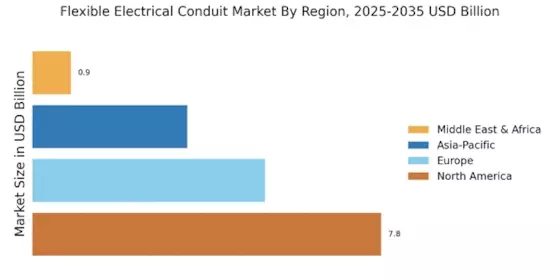Rising Demand for Renewable Energy
The increasing emphasis on renewable energy sources is driving the Flexible Electrical Conduit Market. As countries strive to meet energy efficiency targets, the installation of solar panels and wind turbines has surged. This trend necessitates the use of flexible conduits to protect electrical wiring in diverse environments. According to recent data, the renewable energy sector is projected to grow at a compound annual growth rate of over 8% in the coming years. This growth is likely to create substantial demand for flexible electrical conduits, which are essential for ensuring the safety and reliability of electrical systems in renewable energy applications. The Flexible Electrical Conduit Market is thus positioned to benefit from this shift towards sustainable energy solutions.
Increased Focus on Safety Standards
The heightened focus on safety standards and regulations is a crucial driver for the Flexible Electrical Conduit Market. As electrical installations become more complex, the need for reliable and safe conduit solutions has intensified. Regulatory bodies are continuously updating safety standards to mitigate risks associated with electrical hazards. This trend is particularly evident in sectors such as construction and manufacturing, where compliance with safety regulations is paramount. Recent data indicates that the enforcement of stricter safety codes is likely to boost the demand for flexible electrical conduits, which provide enhanced protection for wiring systems. Thus, the Flexible Electrical Conduit Market stands to gain from the ongoing commitment to safety and compliance.
Growth in the Telecommunications Sector
The expansion of the telecommunications sector is emerging as a significant driver for the Flexible Electrical Conduit Market. With the increasing demand for high-speed internet and advanced communication technologies, the infrastructure supporting these services is rapidly evolving. The installation of fiber optic cables and other communication lines necessitates the use of flexible conduits to ensure protection and organization of wiring. Market analysis indicates that the telecommunications industry is projected to grow substantially, with investments in network infrastructure reaching unprecedented levels. This growth is likely to create a robust demand for flexible electrical conduits, which are essential for maintaining the integrity and efficiency of telecommunications systems. The Flexible Electrical Conduit Market is thus poised to benefit from this upward trend.
Urbanization and Infrastructure Development
Rapid urbanization and ongoing infrastructure development are pivotal drivers for the Flexible Electrical Conduit Market. As urban areas expand, the need for robust electrical systems in residential, commercial, and industrial buildings increases. The construction of smart cities, which integrate advanced technologies, further amplifies this demand. Recent statistics indicate that the construction sector is expected to grow significantly, with investments in infrastructure projected to reach trillions of dollars. This growth necessitates the use of flexible conduits, which offer adaptability and ease of installation in complex building designs. Consequently, the Flexible Electrical Conduit Market is likely to experience heightened activity as urbanization continues to reshape the landscape.
Technological Innovations in Electrical Systems
Technological advancements in electrical systems are significantly influencing the Flexible Electrical Conduit Market. Innovations such as smart wiring and automation require flexible conduits that can accommodate various configurations and installations. The integration of IoT devices in residential and commercial settings is also driving the need for versatile conduit solutions. Market data suggests that the adoption of smart technologies is expected to increase, leading to a higher demand for flexible electrical conduits that can support these systems. As the industry evolves, manufacturers are likely to focus on developing conduits that not only meet current technological needs but also anticipate future requirements, thereby enhancing the overall market landscape.


















Leave a Comment